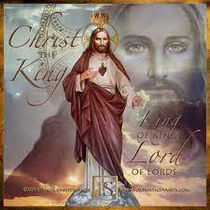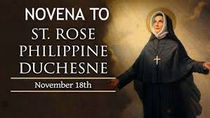The Catholic Defender: The Official Colors of the Catholic Church
- Donald Hartley

- Feb 21, 2021
- 7 min read

Many anti-Catholics will charge that the Catholic Faith is the "Whore of Babylon" citing Revelation 17:4, "The woman was wearing purple and scarlet and adorned with gold, precious stones, and pearls". The Anti-Catholic is attempting to tie the colors purple and scarlet with the Catholic Faith based on their erroneous interpretation of Revelation 17. Is this a true representation that the Anti-Catholics are showing? No, not even close! They want you to believe that the Catholic Faith is the "Whore of Babylon" that is the mother of harlots. Before I want to get into the colors of the Church, I think I have scripture that does point who this "Whore" is! Exodus 25:3 says, "These are the contributions you shall accept from them: gold, silver and bronze; violet, purple and scarlet yarn;" These are not the official colors of the Catholic Faith, but from the Old Testament Israelite (Read the whole chapter of Exodus 26).

St. John is showing that the Jewish people had literally rode on the back of the Roman Empire and he identifies the priesthood of the Israelite.
Actually, St. John does give a great clue identifying who this "Whore of Babylon" is! He reveals this woman to be of "The Great City"? Revelation identifies this Great City as Jerusalem (Revelation 11:8). Revelation 17:18 states, "The woman whom you saw represents the great city that has sovereignty over the kings of the earth.”
So, what are the colors of the Church and what is their purpose? The following is taken from ABC News, "Reading the Colors of the Vatican": White or Gold: Worn during Christmas and Easter, symbolizing the birth and resurrection of Jesus Christ. These colors are also worn during funerals because they symbolize life rather than mourning. These are the pope's colors since the pope is the closest representative of Christ in his glory. Red: The color of blood and, therefore, of martyrdom. Worn on the feasts of martyrs as well as Palm Sunday, Pentecost, Good Friday and celebrations of Jesus Christ's passion. The cardinals wear red because they are considered the closest advisers to the pope and therefore should be ready to shed their blood for the church and Christ. Purple: Worn during the Advent and Lent seasons, purple reflects sorrow and suffering. Sorrow as the faithful await the arrival of the Savior and suffering to mark Jesus Christ's 40 days in the desert (Lent). The color also came to symbolize wealth, power and royalty because in antiquity purple dye was very expensive.

Pink: A special color worn only twice during the liturgical year. It represents a time of joy amid a period of penance and prayer. Green: The default color for vestments representing hope of Christ's resurrection. Blue: Symbol of the Virgin Mary. Usually worn on Mary's Feast day. Black: Used in Masses for the dead as a sign of mourning. It is the color of clerical garb in everyday life. The following is taken from "Catholic News Agency" (CNA) the article called, "The Story behind the White and yellow colors of the Vatican Flag":
L’Osservatore Romano published an article explaining how Pope Pius VII decided in 1808 that the Vatican colors would be white and yellow. Historian Claudio Ceresa explained the history behind the Pope’s choice. In an article entitled, “Two centuries of yellow and white as the papal colors,” Ceresa explained that in order to understand why the colors were chosen, one must consider the “occupation of the city by Napoleonic troops in February of 1808.”

“The commander of the French forces, General Miollis, posted notices on the walls informing that the Pope’s army would be incorporated into the imperial forces. Those officials who remained loyal to Pius VII were to be arrested and deported,” Ceresa explained. “Reaction was minimal because it was reported that the Pontiff was aware and did not resist. Only a small group of loyalists were deported to a prison in Mantova.” “In order to underscore the unification, and probably to increase the situation of uncertainty as well,” Ceresa continued, “the papal soldiers were allowed to continue using the distinctive yellow-red colors on their hats.” Ceresa afterwards noted that the Pope “did not want the Vatican State to be subject to Napoleon, and therefore on March 13, 1808 he forcefully protested. He ordered, among other things, that the units that were still loyal to him substitute the Roman insignia colors with white and yellow.” Abbot Luca Antonio Benedetalla wrote in his diary on the same date that “in order not to confuse the Roman soldiers who were under French command with the few that remained in his service, the Pope ordered the new yellow and white insignia. The noble guard and the Swiss have adopted it. They like it,” he wrote.

Ceresa explained that three days later, on March 16, 1808, Pius VII sent the order in writing to the diplomatic corps, the document is considered to be the act creating the colors of the current flag of Vatican City.”
The colors of the Catholic Faith is not "scarlet and purple" yet people can fall for this kind of attack because they don't know their own history and what the colors mean. The following is taken from the New American Bible (NAB) footnotes covering Rev 13:1-10:
Rev 13:1-10: This wild beast, combining features of the four beasts in Daniel 7:28, symbolizes the Roman Empire: the seven heads represent the emperors; There is little agreement as to the identity of the Roman Emperors alluded to here. The number seven suggests that all the emperors are meant (Rev 17:10). An example of seven can be seen in Rev 1:4 footnote, "Seven churches in Asia: Asia refers to the Roman province of that name in western Asia Minor (modern Turkey); these representative churches are mentioned by name in Rev 1:11, and each is the recipient of a message (Rev 2:1-3:22). Seven is the biblical number suggesting fullness and completeness; thus the seer (St. John) is writing for the whole Church.
Rev 13:2: Satan (Rev 12:9), the prince of this world (John 12:31), commissioned the beast to persecute the Church (Rev 13:5-7).
Rev 13:3:This may be a reference to the popular legend that Nero would come back to life and rule again after his death (which occurred in A.D. 68 from a self-inflicted stab wound in the throat); Rev 13, 14; 17:8. Domitian (A.D. 81-96) embodied all the cruelty and impiety of Nero. (Editors note) This is important to the anti-Catholics who want to claim that the Catholic Church killed 120,000,000 people during the Inquisitions in a 6 century span. The Church itself did not kill anyone though there were a few who did evil. The problem was civil law and the civil authority. The actual numbers are between 2500-5000. What anti-Catholics will not tell you is that 9 out of every 10 persons brought before a tribunal were acquitted of heresy. Many others were offered the chance to repent and recant.

Rev 13:4 Worshiped the beast: allusion to the emperor worship, which Domitian insisted upon and then ruthlessly enforced. Who can compare with the beast: perhaps a deliberate parody of the name Michael; Rev 12: 7-12, Michael, mentioned here in Rev, wins a victory over the dragon. A hymn of praise follows. Michael: the archangel, guardian and champion of Israel (Daniel 10:13-21, 12:1, Jude 9). In Hebrew the name Michael means, "Who can compare with God"? (Editors note) This is why the anti-Catholics push for forgeries to try and claim that the Pope called himself a "god" which is totally false. This is why they try to convince people that "Catholics worship the Pope".
Rev 13:5-6: Domitian, like Antiochus IV Epiphanes (Daniel 7:8, 11, 25), demanded that he be called by divine titles such as our lord and god and Jupiter. Rev 11:2 footnote, The Outer court: the Court of the Gentiles. Trample...forty-two months: the duration of the vicious persecution of the Jews by Antiochus IV Ephiphanes (Daniel 7:25, 12:7); this persecution of three and a half years (half of seven, counted as 1260 days in Rev 11:3, 12:6) became the prototype of periods of trial for God's people; Luke 4:25, James 5:17. The reference here is to the persecution by the Romans. (Editors note) this is important to the anti-Catholics who try to attach the "1260" days to the Papacy. The latest SDA version shows that 538-1798 reveals the Papacy as the "antiChrist". Since the Catholic Faith is nearly 2,000 year old, people can create what ever formula they want to create. Jesus promised the gates of hell would not prevail against it so no weapon formed against it will stand.

Rev 13:5: Forty-two months: this is the same duration as the profanation of the holy city (Rev 11:2), the prophetic mission of the two witnesses (Rev 11:3), and the retreat of the woman into the desert (Rev 12:6, 14)
Rev 13:11-18: The second beast is described in terms of the false prophets (Rev 16:13, 19:20, 20:10) who accompanied the false messiahs (the first beast) Matthew 24:24, Mark 13:22, 2 Thess 2:9, Daniel 13:2-4. Christians had either to worship the emperor and his image or to suffer martydom. (Editors note) The anti-Catholics use this to attack Catholics claiming we worship the Pope, statues, Mary, the Saints. In reality, the Lord is referring to those who would come claiming to be gods, or false prophets who rebel against the Catholic Faith.
Rev 13:18: Each of the letters of the alphabet in Hebrew as well as in Greek has a numerical value. Many possible combinations of letters will add up to 666, and many candidates have been nominated for this infamous number. The most likely is the emperor Caesar Nero, the Greek form of whose name in Hebrew gives the required sum. (The Latin form of this name equals 616, which is the reading of a few manuscripts). Nero personifies the emperors who viciously persecuted the Catholic Church. It has also been observed that "6" represents imperfection, falling short of the perfect number "7", and is represented here in a triple or superlative form. (Editors note) This is important because the anti-Catholics want you to believe the Pope is the anti-Christ. They will claim that the Pope has 666 on the tiria, or that the title Vicarius Filii Dei. The SDA claim this means "Vicar or Representative of the Son of God", it was a phrase first used in the forged medieval document called "Donation of Constantine". The Popes have never used this as a title! It is applied by the enemies of the Church. The actual title is Vicarius Christi; Vicar of Christ; a vicar is the "earthly representative of Christ.





















Comments